No-code development platforms have transformed app development by allowing non-technical users to build custom websites and apps without coding. With the best no-code development platforms, individuals can bring their app ideas to life without extensive coding skills. These platforms provide an intuitive app builder for crafting web, mobile, and native apps, streamlining the process for entrepreneurs and businesses alike.
At Aloa, we provide high-quality software development through our robust project management framework. We connect clients with top development teams, leveraging high standards and the latest industry trends. Whether you're building or creating a web app, we ensure the entire development process is smooth. We guide you from concept to launch, integrating customization options and best practices.
Leveraging our experience, we’ve created this guide to explore the best no-code development platforms. You'll learn about what no-code is, how to build apps without coding, and the best no-code development platforms in 2024. By the end, you’ll know how to quickly build custom apps, focusing on user experience and essential features, without writing a single line of code.
Let's dive in!
What Is No Code?
No code is a development method that allows users to create apps without writing traditional code. These platforms use visual tools, such as drag-and-drop interfaces, and provide pre-built templates to simplify app creation. The best no-code development platforms allow users to build their apps without requiring knowledge of a programming language.
Key Stakeholders of No-Code
The best no-code development platforms appeal to many stakeholders who benefit from these tools' simplicity and speed.
- Process Owners: Process owners can use no-code tools to automate workflows and develop apps that improve business efficiency without coding knowledge.
- Digital Transformation Experts (DT Experts): DT experts leverage no-code development to adapt to market demands quickly, creating solutions faster on platforms designed for speed and ease of use.
- Functional Heads: Department heads who understand the importance of operational efficiency can use the best no-code development platforms to build apps that meet their teams' needs without outside development support.
- Entrepreneurs: Entrepreneurs can use no-code platforms to create their first app without hiring a development team. These platforms provide everything they need to get their product to market quickly.
- Small Business Owners: Small businesses looking to create Android or iPhone apps can do so easily with no-code development tools. These platforms allow them to create professional-grade apps for customer engagement.
How No-Code Development Works
No-code platforms simplify app development through a structured, intuitive approach. Here's how no-code development works:

- Choose a Platform: Select the best no-code platform based on the type of app needed. Whether an Android app, an iPhone app, or a web-based app, selecting the right tool is crucial. Platforms like Webflow or Glide offer unique features depending on the app’s use case.
- Define the App’s Purpose: Clearly defining the app's purpose helps focus development efforts. Whether the goal is to create an app for customer interaction, sales, or team collaboration, understanding the app's purpose ensures better alignment with business needs.
- Drag-and-Drop Interface: No-code platforms feature drag-and-drop interfaces where users can visually place components on the screen, such as buttons, text boxes, and forms. The ease of use allows non-developers to build a functional app without writing code.
- Add Integrations: Many no-code tools allow users to integrate third-party services such as payment gateways, email marketing systems, or CRM platforms. These integrations enable the app to offer complex functionalities with minimal effort.
- Test and Launch: No-code platforms offer testing features that simulate real-world usage before deploying the app on Android or iOS devices. After successful testing, the app is ready for public use.
No-Code Development Features
The best no-code development platforms offer several essential features that enable users to build functional apps without writing a single line of code. Here are some of the key features:
- Drag-and-Drop Builder: This feature allows users to quickly build the layout of their app without needing to understand complex code.
- Pre-Built Templates: No-code platforms offer templates that users can modify to meet the app’s specific requirements.
- Responsive Design: These platforms ensure that apps look good and function well across all devices, from Android to iPhones.
- Integrations with Third-Party Tools: Most no-code platforms come with pre-built integrations, allowing the app to connect to other software tools, such as CRM systems or payment gateways.
- Data Storage and Management: Built-in databases help store and manage app data without needing external solutions.
- Version Control: Users can track changes, allowing them to revert to earlier versions if something goes wrong during development.
- User Management: No-code platforms often include user management features, allowing developers to control access and permissions within the app.
- Analytics Tools: Analytics features help track user behavior and app performance, making it easier to improve the app over time.
Difference Between Low-Code and No-Code Platforms
Low-code and no-code platforms aim to simplify app development but differ in their approach and target users.
| Criteria | Low-Code Platforms | No-Code Platforms |
| Target Audience | Developers with some coding knowledge | Non-technical users or beginners |
| Customization | It is more customizable but requires a little bit of coding knowledge | Less customizable but more straightforward to use with drag-and-drop functionality |
| Programming Language | Requires a basic understanding of programming languages | Does not require any knowledge of programming languages |
| Speed of Development | Fast but may need some coding intervention | Extremely fast, with complete ease of use |
| Use Cases | Complex applications with custom logic and integrations | Simple to medium-complexity applications like websites or mobile apps |
| Deployment | Can be used for enterprise-level applications | Ideal for small businesses or individual entrepreneurs |
| Development Cost | Requires skilled developers, leading to higher costs | Lower cost due to the absence of coding requirements |
| Market Availability | Available for enterprise-level projects and larger apps | Widely available today for small to mid-size apps |
The best no-code development platforms allow non-technical users to quickly build powerful, functional apps. Available today, these platforms provide the tools needed to create an app, whether it’s a single app for internal business use or a customer-facing app for Android devices and iPhones.
The Requirements of Building an App Without Code
Building an app without code is easier than ever, thanks to the rise of the best no-code development platforms. These platforms allow anyone with a great idea to create mobile applications. Below are the essential tools needed to build your app using no-code platforms.
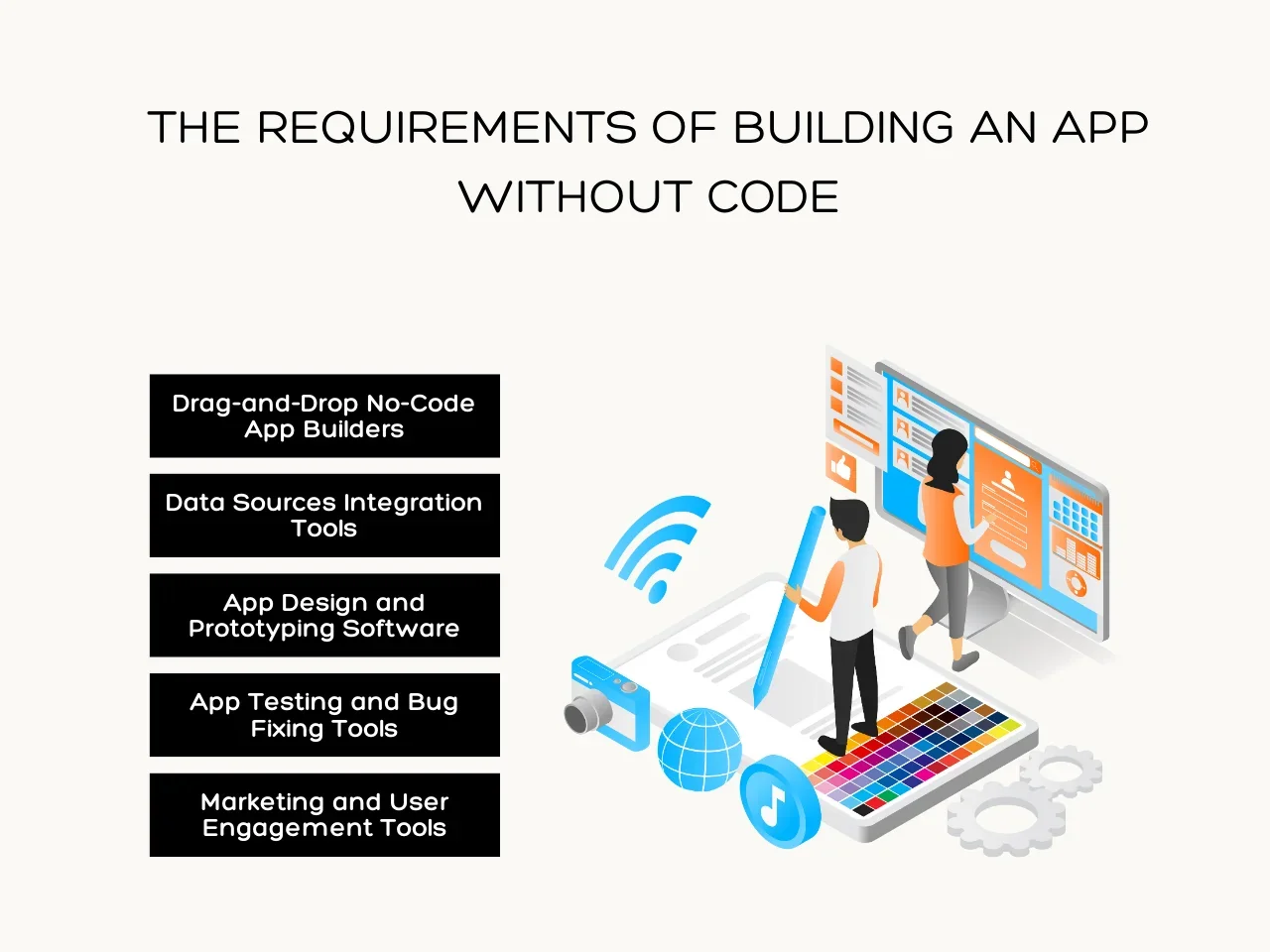
1. Drag-and-Drop No-Code App Builders
No-code development relies heavily on drag-and-drop no-code app builders. These tools offer a visual user interface, allowing users to build their apps section by section. Platforms like Webflow and Adalo make app creation straightforward, allowing you to develop everything from mobile to web applications. With these tools, you can easily add different sections and features to your app, making the process accessible for beginners.
2. Data Sources Integration Tools
A critical part of app building involves connecting your app to various data sources. No-code platforms let you link your app to Google Sheets, social media APIs, and even customer databases through simple integrations. This connection enables real-time data updates and allows you to deliver new features seamlessly. For mobile applications targeting different devices, using data source integration tools enhances your app's functionality, making it more beneficial to your target audience.
3. App Design and Prototyping Software
Designing the app's user interface is crucial, even in no-code platforms. Tools like Figma and Sketch simplify the app design process. They offer pre-made templates and customizable elements for creating visually appealing layouts. With these design tools, you can ensure your app works well on Android and iPhones, improving user reviews and market share in the Google Play and Apple App Store.
4. App Testing and Bug Fixing Tools
Before launching your app on the Google Play Store or Apple App Store, it's essential to test it thoroughly. No-code platforms offer built-in app testing features to help you identify and fix bugs. Although primarily a code tool, Android Studio also allows you to simulate your app’s performance on different devices. Regular bug fixes and updates improve your mobile presence and user feedback, ensuring your app meets the real needs of its users.
5. Marketing and User Engagement Tools
After your app passes the review process on both the Play Store and App Store, engaging with your users becomes the focus. No-code development platforms often include built-in marketing tools like push notifications and email address collection to promote your app. These features increase your app’s visibility and drive user engagement across multiple social media channels.
You can build an app without coding using the best no-code development platforms. From app design to app testing, these tools streamline mobile app development, making it the best way to bring your ideas to life.
5 Best No-Code Development Platforms in 2024
No-code development platforms have transformed app creation, allowing anyone to build apps without coding knowledge. In 2024, the best no-code development platforms enable faster, cost-effective app development using drag-and-drop tools and pre-built templates. Explore the top five platforms to streamline your next app-building project.
1. Webflow - Best for Designers and Developers
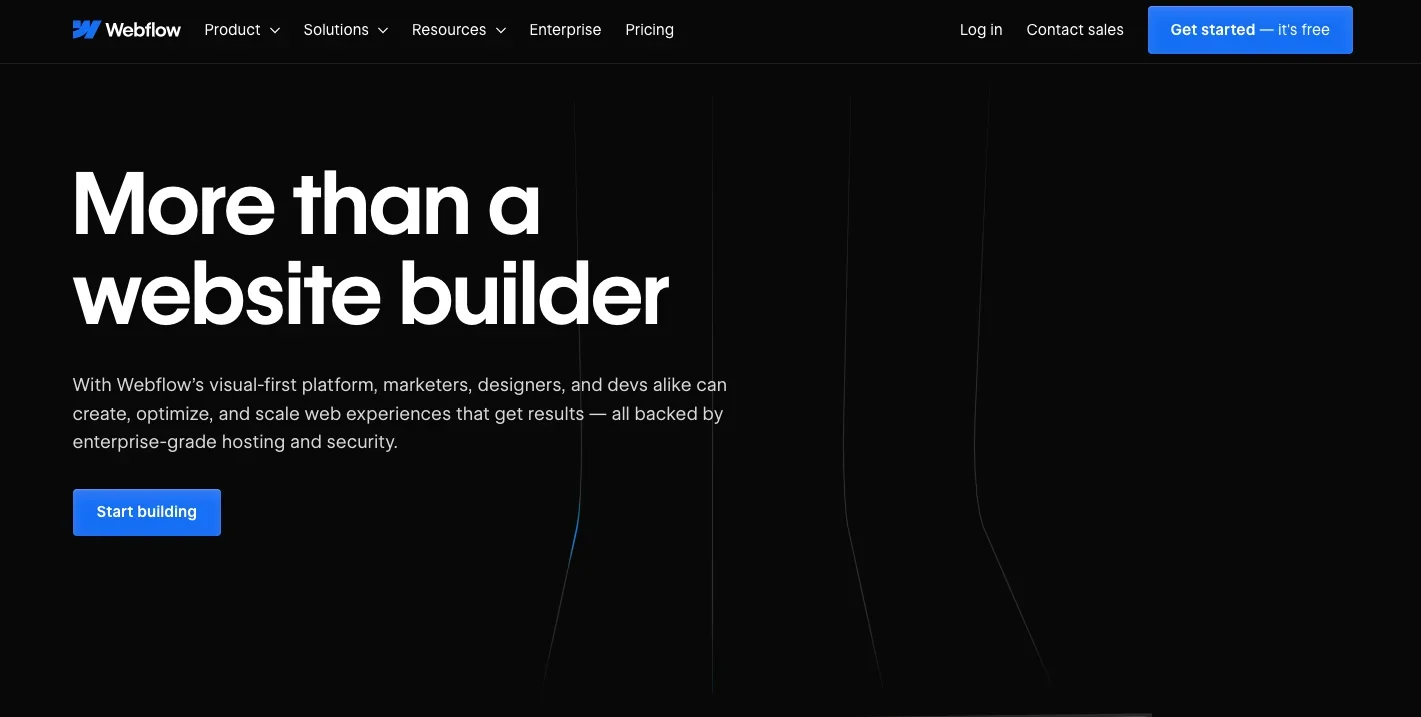
Webflow excels as one of the best no-code development platforms, especially for designers and developers seeking control over their website’s design and functionality. Its visual-first platform allows users to fully customize their websites while generating production-ready code behind the scenes.
What makes Webflow unique is its ability to balance creative freedom and technical customization, a feature few other no-code platforms match. With Webflow, designers can build intricate layouts and interactive animations without writing code. It also integrates powerful hosting solutions, making it a one-stop solution for website building and publishing.
Notable Features of Working with Webflow
- Visual Designer with Full Customization: Designers can create anything from scratch, avoiding restrictive templates.
- CMS Integration: Build content-driven websites quickly through a flexible and composable CMS.
- E-commerce Features: Manage online stores with robust inventory and payment integrations.
- Enterprise-Grade Security: Reliable hosting with built-in security features for businesses scaling websites.
Webflow Pricing Plans
- Starter Plan: Free; limited features, ideal for beginners.
- Basic Plan: $14/month (billed annually); great for simple websites.
- CMS Plan: $23/month (billed annually); perfect for blogs or content-heavy sites.
- Business Plan: $39/month (billed annually); ideal for larger, more complex sites.
- Enterprise Plan: Contact for pricing tailored to larger companies needing advanced collaboration and scalability.
Webflow is suitable for creative professionals, digital agencies, and businesses that prioritize design flexibility and complex interactions. Its versatile no-code platform benefits designers, developers, and content creators.
2. Creatio – Best for Workflow Automation and CRM
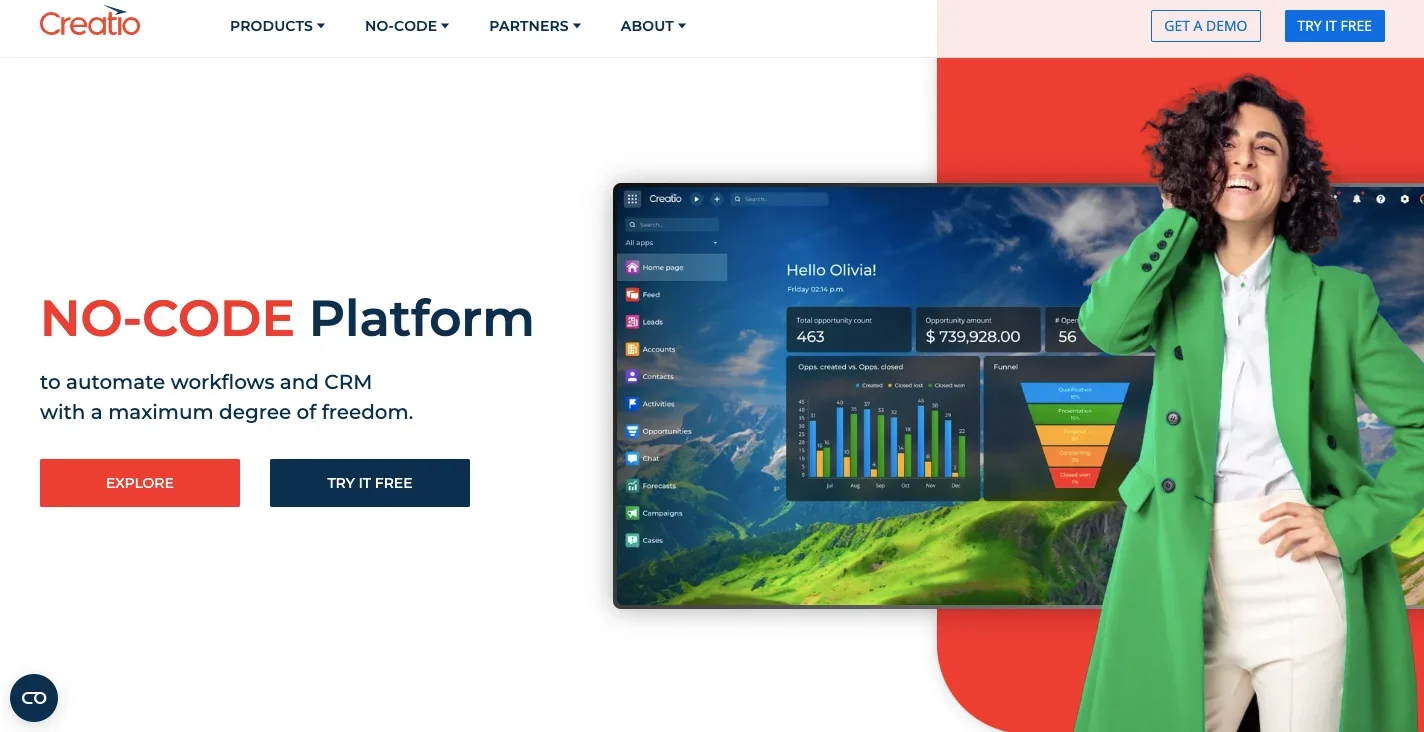
Creatio is one of the best no-code development platforms for businesses looking to automate workflows and enhance customer relationship management (CRM). Through its integrated no-code platform, Creatio excels at enabling enterprises to manage the entire customer journey, from marketing and sales to service.
Creatio offers industry-specific workflows and templates, offering pre-built solutions tailored to various sectors such as banking, retail, and telecommunications. Few platforms provide this level of vertical-specific customization, enabling users to deploy industry-ready apps quickly.
Notable Features of Working with Creatio
- Freedom UI Designer: This tool provides users with maximum creative freedom to design interfaces, leveraging a library of templates and widgets.
- Workflow Automation: Optimizes business processes through advanced automation tools, allowing seamless integration of structured and unstructured workflows.
- Mobile Application Builder: This enables users to build mobile apps without coding, ensuring businesses stay connected.
- Pre-built Industry Solutions: This service offers pre-configured workflows and applications for 20 different industries, reducing setup time and increasing efficiency.
Creatio Pricing Plans
- Growth Plan: $25/user/month, ideal for small to medium businesses automating basic workflows.
- Enterprise Plan: $55/user/month, designed for full-scale enterprise automation needs.
- Unlimited Plan: $85/user/month, perfect for large organizations requiring limitless automation options.
Creatio primarily benefits large enterprises like banking, insurance, telecommunications, and retail. It’s an excellent choice for businesses needing robust CRM solutions alongside workflow automation.
3. Quickbase - Best for Dynamic Work Management
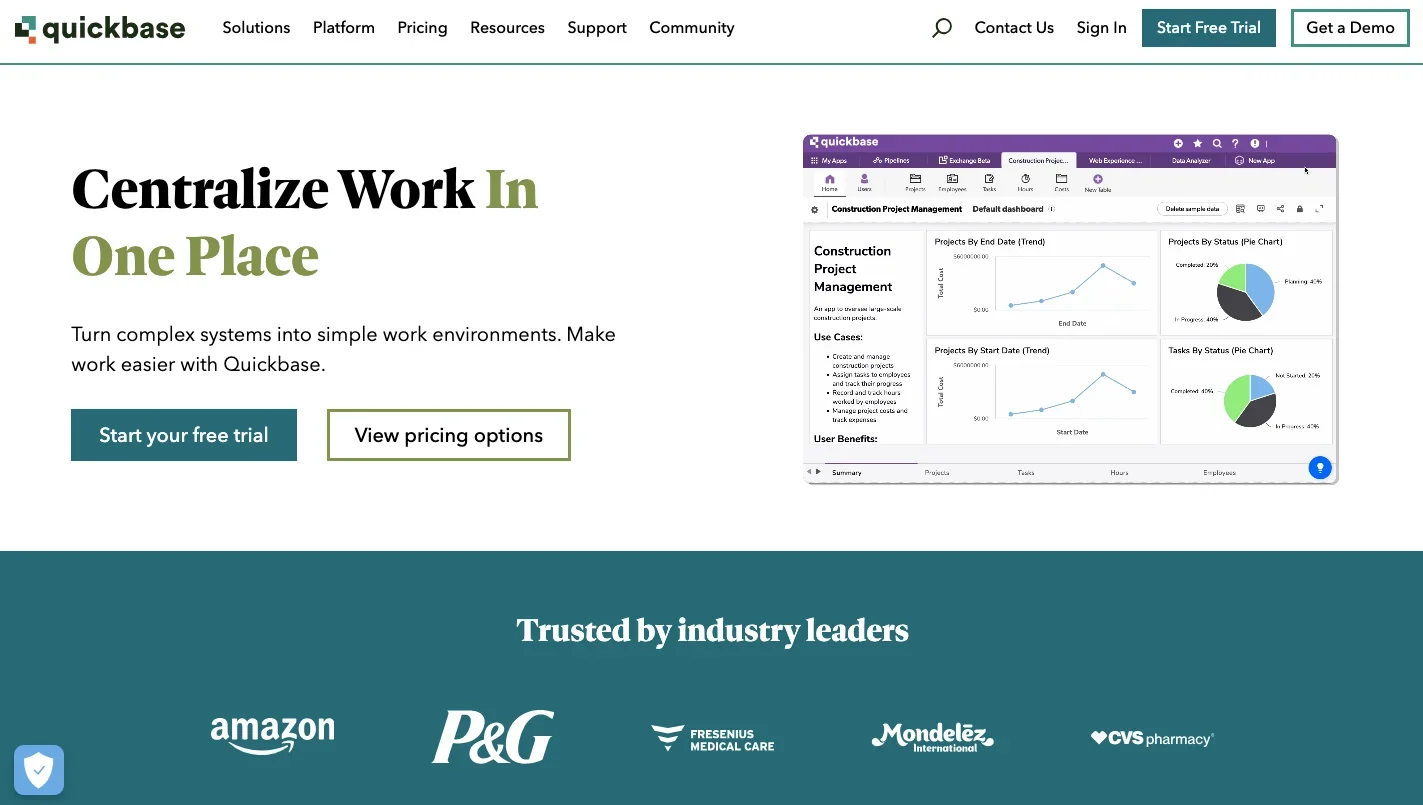
Quickbase is one of the best no-code development platforms for managing dynamic and complex workflows. It allows businesses to build, customize, and automate business applications without coding. Quickbase specializes in helping organizations handle complex projects with ease, offering a flexible platform suited for various industries.
Quickbase's unique focus on dynamic work management allows teams to build tailored applications and automate workflows. The platform integrates external systems and provides real-time insights across all projects. Few platforms offer the level of integration and automation that Quickbase delivers, making it ideal for businesses that need to centralize complex workflows.
Notable Features of Working with Quickbase
- Dynamic Work Management: Quickbase helps manage dynamic processes, from project management to compliance tracking, in one platform.
- Workflow Automation: Users can automate repetitive tasks, reducing manual errors and saving time.
- Integrations: Quickbase integrates with existing systems to bring all project data into one place, ensuring seamless collaboration.
- Real-Time Insights: The platform provides detailed analytics and insights, enabling better decision-making throughout the project lifecycle.
Quickbase Pricing Plans
- Free Trial: 30-day trial to explore all platform features.
- Team Plan: $35/user/month (billed annually), a minimum of 20 users.
- Business Plan: $55/user/month (billed annually), a minimum of 40 users.
- Enterprise Plan: Custom pricing for large organizations needing advanced features.
Quickbase serves industries like construction, manufacturing, and government, where managing complex workflows and dynamic projects is critical. The platform is ideal for organizations looking to automate processes and centralize operations.
4. Bravo Studio - Best for Figma Designers Seeking Mobile App Creation
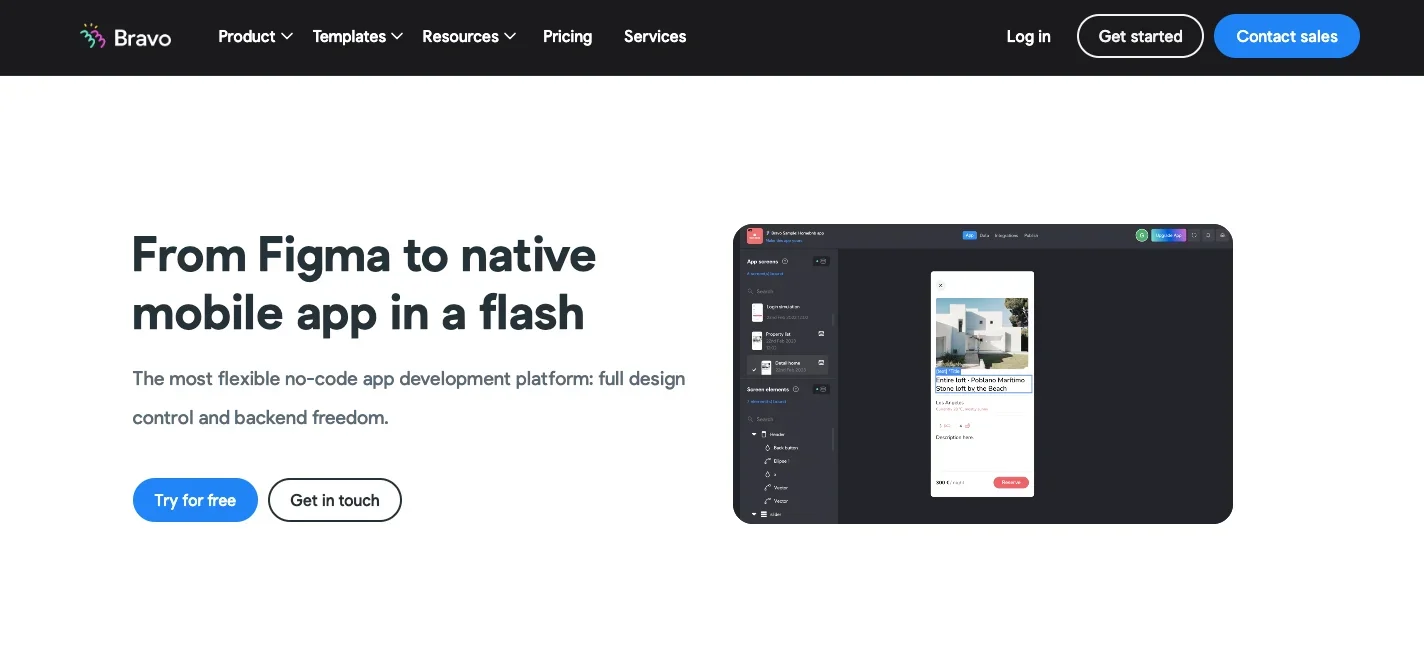
Bravo Studio is one of the best no-code development platforms for designers using Figma. It excels in transforming Figma designs into native mobile apps with ease, providing a seamless design-to-app transition. Bravo’s ability to turn prototypes into real, functioning apps makes it ideal for designers wanting full control over their app’s look and feel.
Bravo's deep integration with Figma allows designers to import visual designs and add functionality without code. Unlike other platforms, Bravo offers native features like haptic feedback and camera integration, providing a more realistic app experience that few others on this list can match.
Notable Features of Working with Bravo Studio
- Figma Integration: Import your Figma designs directly into Bravo, turning static designs into fully functional apps.
- Real-Time Iteration: Make real-time changes to your app, enabling fast feedback and iteration through Bravo Vision.
- Native Features: Add native mobile functionalities such as push notifications, payments, and camera interactions.
- API and Backend Integration: Easily connect your app to external data sources and APIs, enhancing its functionality.
Bravo Studio Pricing Plans
- Starter Plan: Free; limited features, perfect for those starting.
- Solo Plan: $22/month (billed monthly); includes unlimited projects and up to 30 app screens.
- Professional Services: Contact for pricing; ideal for businesses wanting expert help in app creation.
Bravo Studio is most beneficial for designers, app developers, and small businesses that need to prototype and publish apps quickly. It's an excellent fit for those in e-commerce, fitness, and event management who require fast and functional mobile solutions.
5. Voiceflow – Best for AI Customer Experience Automation
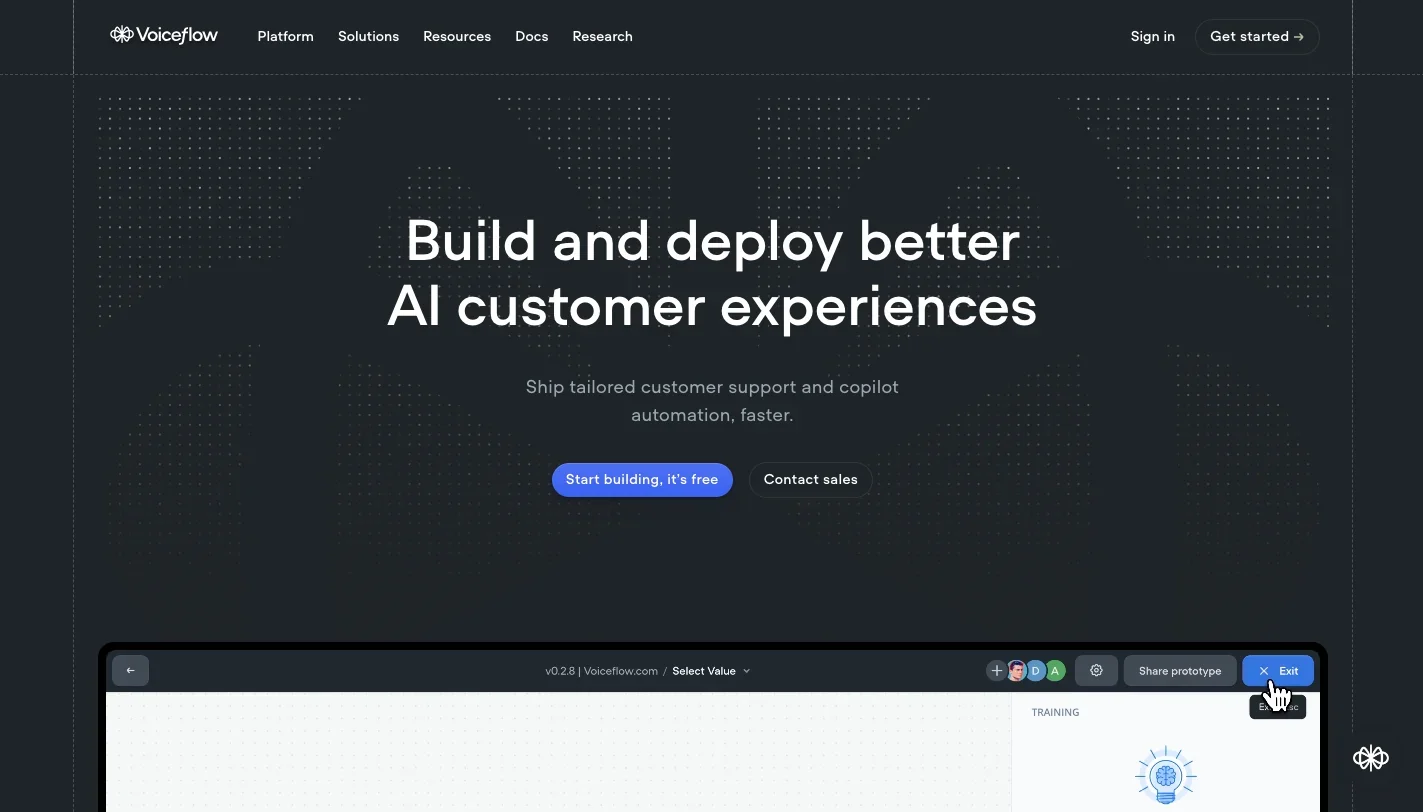
Voiceflow is one of the best no-code development platforms for building AI-driven customer support experiences. It is best for product teams focused on creating conversational AI agents quickly and efficiently. Voiceflow excels in helping teams automate customer support and streamline interaction flows through powerful no-code and code-assisted tools.
Voiceflow allows teams to build advanced customer experiences integrating APIs and third-party systems. The platform also supports multi-LLM (large language model) features, ensuring flexibility when building conversational logic and workflows tailored to any business.
Notable Features of Working with Voiceflow
- Customizable AI Agents: Teams can design agents tailored to specific customer interactions and support needs without technical limitations.
- Workflow Builder: A drag-and-drop tool that simplifies creating complex, multi-step tasks for AI agents.
- Multi-LLM Support: Voiceflow works with any AI vendor, giving teams flexibility in choosing and switching AI models.
- API Integrations: Seamlessly integrate with third-party services to enhance agent capabilities, from data retrieval to executing tasks.
Voiceflow Pricing Plans
- Sandbox Plan: Free, limited to 2 agents and 50 knowledge base sources per agent.
- Pro Plan: $50/month per editor, ideal for small teams building up to 20 agents.
- Team Plan: $125/month per editor, unlimited agents, and priority support.
- Enterprise Plan: Custom pricing, suitable for large organizations needing advanced features like private cloud hosting and custom SLAs.
Voiceflow is most suitable for enterprises and product teams that need to automate customer support, streamline workflows, and build AI-driven tools. Its flexibility makes it ideal for businesses looking to enhance customer experience through automation.
Key Takeaway
The best no-code development platforms offer an effective way to build apps without requiring technical expertise. These platforms use visual tools like drag-and-drop interfaces, allowing non-technical users to create fully functional apps quickly and efficiently. Whether you're designing websites, mobile apps, or automation tools, these platforms make app development accessible.
Using the best no-code development platforms, users can develop apps faster and cheaper than traditional development methods. These platforms also provide pre-built templates and easy integrations, reducing the need for expensive developers and minimizing the time spent on project completion. This makes them ideal for small businesses, entrepreneurs, and even larger companies looking to streamline their development process.
Are you ready to explore the best no-code development platforms for your project? At Aloa, we will guide you through selecting and implementing the right platform for your specific needs, helping you bring your app idea to life efficiently.

